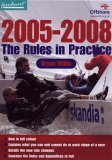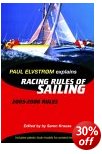

Trapeze Techniques.
This article comes from the Hornet Class,
and has been adapted to be relevant to all trapeze classes, some good tips on
weight, kinetics and stance. Follow the link here
and use the back button on your browser to return to this page.
Laser sailors help is at hand!
 The book, which includes a CD-ROM, is a comprehensive text about how to sail a
Laser to gold medal winning standard. Each page has sequential colour
photographs, which complement the text, and then video showing the same
manoeuvres can then be played from the CD-ROM. All the video and photo sequences
are of Ben sailing his gold medal winning boat and the video commentary is by
Ben himself explaining how to execute the manoeuvres.
The book, which includes a CD-ROM, is a comprehensive text about how to sail a
Laser to gold medal winning standard. Each page has sequential colour
photographs, which complement the text, and then video showing the same
manoeuvres can then be played from the CD-ROM. All the video and photo sequences
are of Ben sailing his gold medal winning boat and the video commentary is by
Ben himself explaining how to execute the manoeuvres.
If you want to go faster in you Laser then surely this book and CD Rom are a
must, currently available from
Amazon.co.uk at 20% off list price.
Know the Rules. Make sure you use the rules to your advantage, you can build you knowledge with the following books, available direct at discount prices from Amazon.co.uk, lets face it we all need a rules book, either for the protest hearing or to make the point in the bar after the race.
 The best selling rules book now updated and corrected to take into account the
2005 rule changes. The book applies the rules to common situations that can
occur on the racecourse. It analyses them and interprets the rules that apply in
the situation. Simple to understand - essential reading.
Order Now Available
The best selling rules book now updated and corrected to take into account the
2005 rule changes. The book applies the rules to common situations that can
occur on the racecourse. It analyses them and interprets the rules that apply in
the situation. Simple to understand - essential reading.
Order Now Available
|
 The 15th edition of this bestselling pocket reference for racers has been
completely revised to cover the new rules for 2005-2008. It includes the full
text of the new racing rules and provides a careful analysis of each rule and
the situations likely to be met with in a race. The book includes 2 colour
'bird's eye' line drawings cross-referenced to the relevant rule to assist
understanding, model boats very popular for use in protests, and a plastic
wallet to carry the model boats and protect the book.
Order Now
The 15th edition of this bestselling pocket reference for racers has been
completely revised to cover the new rules for 2005-2008. It includes the full
text of the new racing rules and provides a careful analysis of each rule and
the situations likely to be met with in a race. The book includes 2 colour
'bird's eye' line drawings cross-referenced to the relevant rule to assist
understanding, model boats very popular for use in protests, and a plastic
wallet to carry the model boats and protect the book.
Order Now
|
 This bestselling pocket-sized racing rules book is unique in covering the rules
by race situation and has been fully revised for this edition. The entire 2005 -
2008 racing rules are included. In revising The Rules Book to take account of
the rule changes, Bryan Willis has maintained Eric Twiname's unique method of
presentation, which has proved popular with racers over many editions.
This bestselling pocket-sized racing rules book is unique in covering the rules
by race situation and has been fully revised for this edition. The entire 2005 -
2008 racing rules are included. In revising The Rules Book to take account of
the rule changes, Bryan Willis has maintained Eric Twiname's unique method of
presentation, which has proved popular with racers over many editions. Order Now |
Or test yourself and your friends with 100 Best Racing Rules Quizzes : Based on the Racing Rules of Sailing, 1997-2000 by The United States Sailing Association.
Get Out There and Compete.
Believe me once you have mastered the art of keeping you boat upright, the
fastest way to progress is to go out and race. Don't make a nuisance of
yourself, but do explain to others that you are just starting to race, and the
support and encouragement you get will surprise you.
We all want to sail in bigger fleets and every new sailor is welcome, we all
started somewhere! Racing will also give you two things. One a sense of purpose
a reason to concentrate harder, and secondly a measure of your progression.
Over the years I have seen many novices start racing and the rate at which they
progress is astounding, they gain boat handling skills far quicker than anybody
that just potters around and before long they are challenging many experienced
sailors.
Choose Your Clothing Wisely.
While many spend much time, effort and money on fitting out their boats to work
efficiently and lets face it probably thousands of pounds on the boat and sails;
one of the areas that is regularly neglected is the clothing we wear. To sail
efficiently you will need several sets of sailing gear.
Drysuits are now just about mandatory for the coldest months, and to be at their
best you will need the right layers to wear underneath, see the manufacturers
web sites for details. Spring and autumn will require the use of a full wetsuit
at least, and you will probably need a shortie for the summer. Spraytops, hifits
or a coverall suit will need to be added together with good sailing boots and a
buoyancy aid.
Everybody will have their favourites as to brands and I suggest you start by
looking at the sites on the links page, many items can
be bought online but at a local chandler you can try the items on. This brings
me to my final point, make sure that as well as being warm the clothing is
comfortable, and allows freedom of movement, restrictive clothing will be slow
clothing so choose wisely.
Buy out of Season.
We all need to spend money on our sport at some time, it may be new ropes, a new
drysuit or boots or even a new boat.
But whatever you need try to look ahead and don't buy in haste, chandlers and
other suppliers know that during the summer nobody wants to be off the water
longer than necessary, so prices will naturally be higher, prices don't go up,
but most things are sold at full retail.
During the winter months we can afford the time to shop around and use mail
order so the prices go down, competition is fiercer and sales a plenty.
So plan ahead look for the bargains and buy when prices are low, even if the
gear is not needed for a few months, you will be able to tell endless stories at
the bar or how you saved 30% here and 40% there.
The above comments also apply to buying boats, especially secondhand. People
selling boats at the end of a season would far prefer to offload the boat before
the winter, it means they do not have to carry out maintenance, and the boat is
not taking up space. You should be able to get more bargains in the winter.
Try our Free Ads.
Getting Ready for the Season. When the warmer months are approaching for many that means the time to get the boat ready.
However your boat was stored during the cold months, you must give it a thorough
check up before launching it again. An article on this subject could take many
pages, but lets just highlight the important areas.
Check the hull for water damage. This may have occured if water has been trapped
anywhere, it will probably have frozen, expanded and caused damage, all repairs
must be done so as to prevent further water penetration, and hence damage. Check
also the foils, these are regularly damaged and open areas must be sealed and
returned to their original shape.
Check all fittings, do they still work? are they secure? tighten bolts etc. pay particular attention to high load areas, rudder fittings and mast step. Check the rigging for damage, even normal wear and tear could well have been ignored last year in the hurry to pack the boat away, if finances allow preventative maintenance is a good idea, replace all old wires and ropes. Pay particular attention to the points where sheets and halyards rub.
Check out the sails, let's hope they were stored clean and dry! Are they damaged
and require repair? check the ends of the batten pockets. As a matter of course
I would rig the boat at home before taking it to the club, this should ensure
you have all the bits together and everything still works, take a toolkit the
first time you go sailing, and don't launch 5 mins before the start, go for a
sail first.
Don't forget your sailing gear, does the drysuit require new seals? and have
your boots begun to perish? did you store them somewhere dry? Have you outgrown
your wetsuit? many chandlers still have winter offers on.
If you're confident the boat will stay together check your documents,
certificate, insurance, and pay you class and club fees.
Finally go sailing and have a great year!!
Time Your Start.
You know how it is when the 5 min gun goes. You are allways tacking, gybeing or
busy doing something in the boat that stops you from starting your watch. You
end up starting it a few seconds later and being shy of the line at the start.
Well before you go on the water set the watch for the required countdown and
start it. Count 3 seconds,one thousand and one one thousand and two etc, then
stop it, and when the first gun goes start counting again, you have 3 seconds to
get to your watch and at the end of the 3 second count start the watch which is
already 3 seconds advanced. Hey presto you are exactly in time with the race
officer.
Championships and Sea Sailing.
For those who sail at inland clubs the National Championship my be their only
sea event of the year, or maybe a couple of open meetings on the sea, but
whichever the strains and stresses on your boat will be far greater at sea than
on an inland venue.
So prior to any event make doubly sure the boat is sound. This is good practice
anyway but if it is your only sea based event you may need to reinforce some
areas of your boat. Pay particular attention to how secure your fittings are,
always use bolts not screws, check the rudder, both the stock and mountings are
vulnerable. Ensure the mast step in solid and the mast fits tight into it. Check
all mast fittings and renew any suspect rivets. Finally a good tip is to use
'loctite' on all bolts as this will stop them working loose.
These are all things good sailors will check regularly, but please pay
particular attention at sea, I know because I once lost a safe second place at
an Osprey Nationals when my rudder came apart on a reach, and this cost me a top
10 place overall.
Altering the Setup. We all do it, we think there must be a better way to organise the boat. We change the control lines, move the position of the cleats, move the toestraps and generally fiddle with the settings of the boat. Well yes we must experiment, but how often do you say to yourself you will get used to it, and its only a matter of time before you find the new system second nature. Well I believe as a general rule if it doesnt feel right first time ditch the idea as all you are doing is adjusting for the sake of it, if its better it will be better first time. Thanks to Mike at QCS Care Plan System, kudos!
Start at the Top. Somehow these days crewing does not seem fashionable, and is often looked down on, with all the accolades going to helms. However a quick glance at the results in top class fleets will often show helms now at the front who started crewing for the fleet leaders a few years ago. They learnt faster than most and got used to being at the head of the fleet. The result being that when they moved to the back of the boat they were not only confortable in the lead but expected to be there. Crewing for top helms is a great way to learn the sport and will improve all your skills faster than following them round the racecourse.
Boat Handling Want to improve your boathandling. Then pick a day with a moderate breeze and find a quiet piece of water, probably inland at first. Sail out into the middle, take the rudder off, and sail the boat by sail trim and heel anly. You will be surprised by how much the boat alters course using just these, and with time will be able to sail quite competently without a rudder. This will help a lot in tight situations around the racecourse and you will realise what the forces on the boat are when sailing. Good luck, as you will probably look a little daft at first, and be careful not to capsize and loose the rudder, it may not float!
The following comments have been added by Nick Hurst.
However, sailing without the rudder to improve boat handling gives a
misleading impression of the boat - especially in these days of big blades.
So centre the tiller with some bungee-cord and DON'T TOUCH IT instead. This way,
the centre of resistance is in the same place under the boat.
The risk of losing the rudder in a capsize is also reduced.
Regards,
Nick Hurst
Look and Talk
You must have heard it before, but it is true, go and look at the top boats.
Start by copying their setup, after all it must be fast.
Then talk to the
top sailors, most are more than happy to chat, and it will probably only cost
you a pint. Ask them why they have the boat the way it is? and how they handle
the boat in different conditions?, you may be surprised: and find that much is a
compromise and not an out and out setting or method! But dont take my word for
it, ask.
A fleet will only get faster if ideas are shared and the top guys
feel pressure and the need to go faster, this must surely help everybody.
Why not send in your tips and help somebody go a little bit faster.
UK Dinghy Racing
Designed By: Xpert Web Builder.